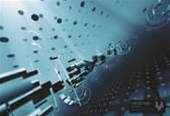
The team from Princeton University has devised a way of eliminating the tiny air bubbles that form when liquid droplets are moulded into intricate circuits, clearing a sizable obstacle to the mass production of nano-scale circuits.
Led by Stephen Chou, the Joseph C. Elgin professor of engineering at Princeton, the team worked to troubleshoot one form of nano-imprint lithography, a method invented by Chou in the 1990s.
Nano-imprint uses a nanometre-scale mould to pattern computer chips and other nanostructures, and is in marked contrast to conventional methods that use beams of light, electrons or ions to carve designs onto devices.
The new technique allows for the creation of circuits and devices with features that are not much longer than a billionth of a metre, more than 10 times smaller than is possible in today's mass-produced chips, yet more than 10 times cheaper.
The researchers explained that, in dispensing-based nano-imprinting, liquid droplets on the surface of a silicon wafer are pressed into a pattern which quickly hardens to form the desired circuitry.
This technique is more attractive to manufacturers than some other forms of nano-imprinting because it does not need to be done in an expensive vacuum chamber.
However, the widespread use of the technique has been hindered by the formation of gas bubbles that distort the intended pattern.
"This is an important step because to benefit from the technology of nano-imprinting you need to be able to use it in mass manufacturing at low cost, " said Professor Chou.
The team's findings are reported today in Nanotechnology.



_(20).jpg&h=140&w=231&c=1&s=0)
_(22).jpg&h=140&w=231&c=1&s=0)





 iTnews Executive Retreat - Security Leaders Edition
iTnews Executive Retreat - Security Leaders Edition











_(1).jpg&h=140&w=231&c=1&s=0)



